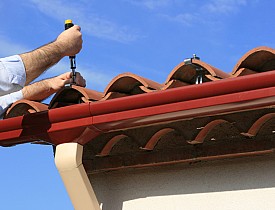Is it time to gut your gutters?
 For all the protection and peace of mind gutters provide, they don't ask for much in return. If you keep them clean, stable, solid and rust-free, they should keep water off the house and out of the foundation. Eventually, of course, they will need to be replaced, but here is a guide for when and how to repair gutters, and when and how to gut them and start over.
For all the protection and peace of mind gutters provide, they don't ask for much in return. If you keep them clean, stable, solid and rust-free, they should keep water off the house and out of the foundation. Eventually, of course, they will need to be replaced, but here is a guide for when and how to repair gutters, and when and how to gut them and start over.
When and How to Repair
The following gutter problems need to be addressed quickly, but should not require a full replacement.
• If water is dripping out of a small number of puncture holes, you can fill them with specialized silicon gutter and flashing caulk.
• For larger holes, thoroughly brush or cut away any rust and patch with roofing cement and a repair patch, if necessary. Be sure to buy a patch of the same metal as your gutters. If you try to patch steel with aluminum, for example, the metals are likely to corrode each other.
• Leaky gutter seams can also be filled with gutter and flashing caulk. If you can't see any rust or other problems, the caulk on the seams likely wore out.
• If the gutter is still in good shape, but you see water stains behind the gutter, or see water dripping between the roof and gutter, you may need to reattach the gutter in those spots. If you have the standard spike-and-ferrule setup (long nails hammered into the roof from the outside edge of the gutter through small tubes holding them in place), hammering the same nail back into place will not work. It will simply come loose again. Instead, get some 7-inch gutter screws and reattach the gutter.
Gutters need to be patched or re-attached quickly before they start to warp and sag and before the rust spreads, so be sure to inspect the gutter lines at least twice per year.
When and How to Replace
Even with regular inspections, you can expect to replace gutters after about 20 years or when they have more than a few rust spots, serious damage from falling limbs or other problems that are beyond repair. You have various options for replacement gutter materials.
• Vinyl is the cheapest, but it contracts and expands with the weather, and has seams. This all means it won't last as long, and requires more maintenance.
• Copper and wood may be particularly attractive, but also are the most expensive options.
• Galvanized steel is strong and durable, but is prone to rust.
• Aluminum gutters are not quite as strong as steel, but are more rust-resistant. Many gutter installers have a specialized machine in their trucks that can make seamless aluminum gutters to custom lengths on site. To save some money, find a contractor willing to make and sell the gutters on site, but allow you to install them.
Regular maintenance and inspection of gutters can make them last for decades, but nothing lasts forever, and they will eventually need to be gutted. Thankfully, replacing them is a relatively simple DIY task.
Looking for a Pro? Call us (866) 441-6648

Roofing Average Costs
Roofers Experiences

Roof Replacement: How To Get Your Money’s Worth

We Needed A Roof Cleaning By Our Insurer’s Deadline



